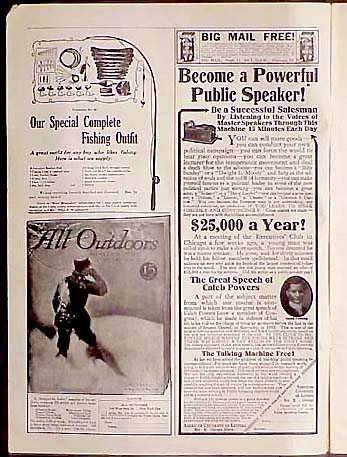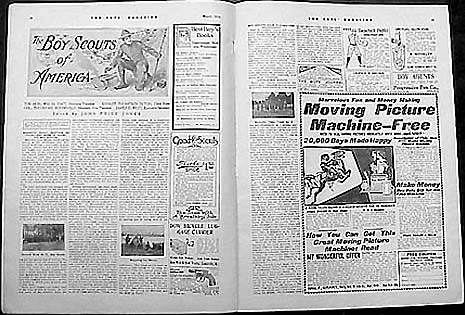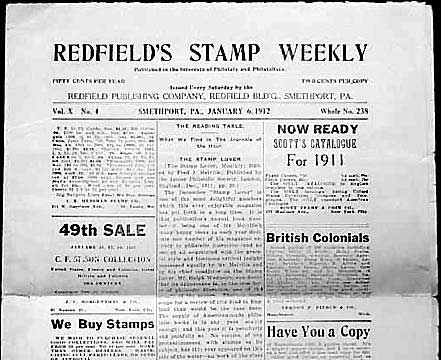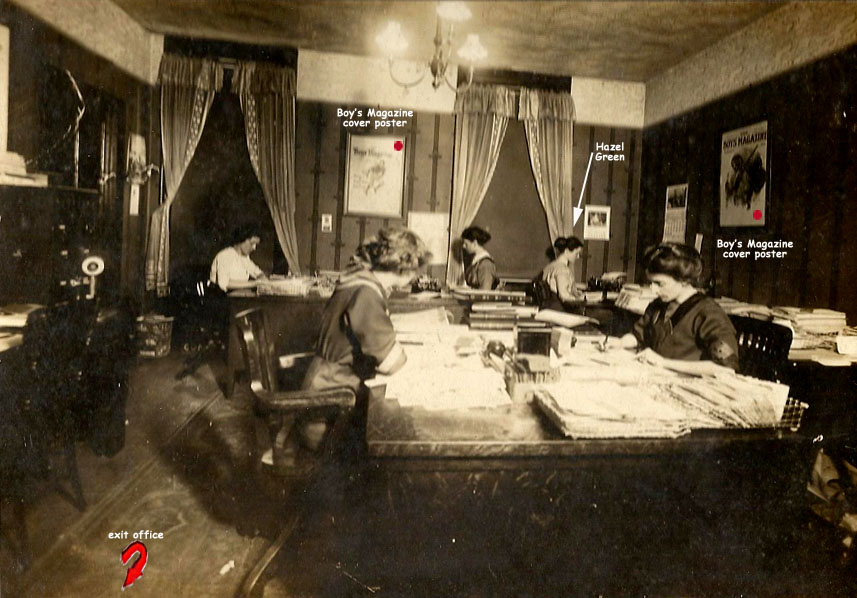The Boys' Magazine (1910-1920)
VOLUME AND ISSUE DATA
(vol. 1, no. 1-vol. 11, no 12)
PUBLISHER AND PLACE OF PUBLICATION
Scott F. Redfield Co., Smethport, Pa (1910-1920)
EDITOR
Scott F. Redfield (1910-1911); Walter Camp (1911-1915);
Scott F. Redfield (1915-February 1920);
Herbert Hungerford (March-September 1920); Scott
F. Redfield (October-December 1920). (research source- Scot Guenter)
From 1910 to 1921 The
Boys' Magazine offered young man a monthly publication that combined
the adventure and suspense of dime-novel fiction with the more acceptable
juvenile literature in which proper behavior reaped rewards and stories
had obvious morals. With entertainment its primary purpose,
The Boys' Magazine also sought to mold character, encourage
fitness, and develop interest in hobbies and skills.
The thirty-two-page magazine sold for $0.10 a
copy, or $1 a year, and was published by the Scott F. Redfield Co.
in Smethport, Pennsylvania, a small town in the then thriving Pennsylvania
oil fields.  Redfield,
born in 1880 in Washington, D.C., the son of a newspaper reporter,
moved to Smethport and married into a prominent local family. He was
involved in real estate and automobile sales before his publishing
venture and edited the magazine throughout most of its existence.
Redfield,
born in 1880 in Washington, D.C., the son of a newspaper reporter,
moved to Smethport and married into a prominent local family. He was
involved in real estate and automobile sales before his publishing
venture and edited the magazine throughout most of its existence.
The Boys' Magazine presented short stories
and serialized longer pieces in which the hero
was a teenage or young adult male. It also included articles
on exemplary young men, athletics, and hunting, as well as regular
departments that were an important part of the periodical in its first
eight volumes. George Avison illustrated almost all of the covers
and a high percentage of the stories published, although the artwork
of other artists, such as A. O. Scott and Clare Angell, was regularly
used too.
Most of the fiction was dramatic and exciting,
placing the young heroes in perilous situations that called for bravery
and clever thinking. Conventional narrative forms predominated:
historical fiction, technology and transportation, confrontations
with bank robbers, Indian life, prep school or college life, sports,
and nature adventures.
The smallest category, historical fiction, included
serialized accounts of young men's patriotic efforts during the American
Revolution, such as John T. McIntyre's: Young Continentals at Bunker
Hill" (January 1910 and following and following issues) and Everett
T. Tomlinson's "Light Horse Harry's Legion" (August 1910 and following
issues). One other historical topic for fiction was the taming
of the old West, but the majority of stories were given a contemporary
setting.
Some of the stories dealt with young men's adventures
in aircraft, automobiles, and trains. A positive attitude toward
technical knowledge was reinforced in these stories, encouraging the
readers to learn how to operate and care for mechanical equipment.
The opening issue contained "Skimming the Skies," a serialized tale
of two bright young men who not only build and fly dirigibles but
also catch thieves. "Gasoline Bronc" (July 1915) by George M. Johnson
illustrates the superiority of modern technology: a ranch manager's
son uses his motorcycle to break through and Indian attack and bring
back help to rescue the surrounded cowpunchers. In several of
the railroad stories, such as Roe L. Hendrics's "Return to Duty" (April
1913) and C. H. Claudy's "Dick's Start" (February 1911), near wrecks
are averted at the last minute by quick-thinking youths who comprehend
the intricacies of dispatching and telegraph communications.
Another tale clearly stressing the need to master modern communications.
Another tale clearly stressing the need to master modern communication
skills is "The Surrender of Father" (January 1915) by Maud Mary Brown,
a story in which the hero assembles a wireless transmitter and calls
in aid to put down a strike in his father's coal mine.
Bank Robbers were regularly foiled in The Boys'
Magazinefiction by brave young men who used their wits. "The Proving
of Billy" (February 1915) by Gardner Hunting, "When the Hour Struck"
(January 1911) by J. S. Danielson, and "Fixing a Robber" (February
1913) by Harry W. Newcombe exemplify this type of story. Indian
stories were also very popular, whether in an entirely Indian cultural
setting or in recounting a clash with white traders or settlers moving
west. A large number of the Indian stories published in The
Boys' Magazine were by Ernest Carliowa, a regular contributor.
Slightly more numerous are stories depicting
prep school and college life, often emphasizing
the team sports offered by such institutions.
John Clair Minot wrote a succession of stories
recounting the adventures of young university men, including
"The Entombed Feud" (January 1910) and "A Husking Checker's Experience"
(February 1910). "Fenton's Debt" (January 1912) by E. M.
Jameson
shows the influence of Burt L. Standish's
"Frank Merriwell" series, a bully creating fear among
smaller classmates. Serials about  football
and baseball team activities included "Left End Edwards"
(September 1915 and following issues) by Ralph
Henry Barbour and several stories by William Heylier,
including "Fair Play" (March 1915 and following
issues), "Five Yards to Go" (January
1913 and following issues), and "The Winning Hit" (June 1916
and following issues), was written by Zane Grey, best known
for his popular western novels. Other sports
were also given attention in The Boys' Magazine,
notably sailing and track.
football
and baseball team activities included "Left End Edwards"
(September 1915 and following issues) by Ralph
Henry Barbour and several stories by William Heylier,
including "Fair Play" (March 1915 and following
issues), "Five Yards to Go" (January
1913 and following issues), and "The Winning Hit" (June 1916
and following issues), was written by Zane Grey, best known
for his popular western novels. Other sports
were also given attention in The Boys' Magazine,
notably sailing and track.
Nature adventures made up the largest single group
of short stories in The Boys' Magazine. These
stories were of two basic types: stories of young men
who battle the elements and stories of young men who confront
wild animals. Examples of the first type include
Hugh F. Grinstead's "Flood and Its Messenger" (December
1914), Arthur Knowle's "Adrift on an Ice Raft" (January 1913), and
Archibald Rutledge's "Vine and the Whirlpool" (February 1913).
In the second type of these stories, the animal might be a puma,
a panther, or even a bear, but always the
young hero narrowly escapes a grisly death.
Examples of this type include "A Tussle with a Wildcat"
(March 1915) by Ladd Plumley, "The Worthlessness of Buster"
(February 1913) by Roe L. Hendrick, and "A Crop
of Sweet Corn" (August 1914) by Harrison R. Heath.
A fascination with the great outdoors is apparent
in many serials as well, notably the string by Hugh
Pendexter: "The Young Lumbermen," "The Young Prospectors," "The
Young Forest Rangers," "The Young Timber- Cruisers," and "The Young
Gem hunters."
Although most of the magazine
was devoted to fiction, articles also
appeared. Usually, they presented and exemplary
young man as a role model of offered tips on athletics,
hunting, or fishing. Occasionally, articles appeared urging
correct moral behavior (such as temperance) or discussing geographical
wonders, but they were not very common. John L.
Harbour was responsible for many short, inspirational,
biographical pieces, such as "Our President's Young Son"
(January 1913), concerning Charlie Taft, and "From Messenger
Boy to Fifty-Thousand Dollars a Year" (January 1912), the rags-to-riches
story of corporation president Belvidere Brooks. Advice
articles on sports or hunting were penned
by experts, such as baseball professional
Billy Evans's serial "Developing a Crack
Baseball Team" (July 1913 and following issues)
and the reoccurring tips on shooting by Warren H. Miller, editor of
Field and Stream.
From the start a heavy
emphasis was placed on regular departments.
Alfred P. Morgan edited a monthly column on electricity
and mechanics, Arthur Mallett edited on stamps and coins,
and Donald  Grandon
edited another on photography. Day Allen Wiley's
"Curios Department" disappeared in May 1910, and A. Neely
Hall's "Carpentry Department" debuted in March 1910. Both
in emphasis and presentation, the most significant
department dealt with athletics and was edited by Walter Camp, originator
of the first All-American football team. Cam's name
and influence were so integral to The Boys' Magazine
that in November 1911 he was made editor-in-chief, responsible
for a monthly editorial on sportsmanship. Redfield
made himself editor again in 1915, dropping
Camp to the status of contributing editor. An article by Simon
T. Dillon, "Boy Scouts Movement" (December 1910), led to the inauguration
of a monthly column edited by John Prine Jones.
Devoted to the activities of the Boy Scouts
of America, this column extolled their work and
encouraged membership. Beginning in August
1911, it predated Boy's Life,* which did not
start publication until the following July.
Grandon
edited another on photography. Day Allen Wiley's
"Curios Department" disappeared in May 1910, and A. Neely
Hall's "Carpentry Department" debuted in March 1910. Both
in emphasis and presentation, the most significant
department dealt with athletics and was edited by Walter Camp, originator
of the first All-American football team. Cam's name
and influence were so integral to The Boys' Magazine
that in November 1911 he was made editor-in-chief, responsible
for a monthly editorial on sportsmanship. Redfield
made himself editor again in 1915, dropping
Camp to the status of contributing editor. An article by Simon
T. Dillon, "Boy Scouts Movement" (December 1910), led to the inauguration
of a monthly column edited by John Prine Jones.
Devoted to the activities of the Boy Scouts
of America, this column extolled their work and
encouraged membership. Beginning in August
1911, it predated Boy's Life,* which did not
start publication until the following July.
The departments were converted
of disappeared during a reorganizational shakeup
of The Boys' Magazine that occurred in the
premiere 1915 issue. Herbert Hungerford
was made "chief booster" and ostensibly took
over the editing of the magazine, although Redfield retained
the title. Formerly active in the YMCA and creator
of the first Boy's Success Club in New York, which developed
into the later Success League, Hungerford sought to make the
periodical more dependent on reader submissions
with an expanded Prize Department. He also enlisted
the aid of Orison Swett Marden as
contributing editor on success winning
and character building topics; Warren H. Miller
as outdoor life editor; Spencer Hord
of Kodak as photography editor;
Jack Glennister, founder of Boys' Life, as athletics editor;
and Edna Earle Henderson as nature editor.
Circulation was listed as more than 100,000
by April 1915 and more than 110,000 by July 1915, but there
were signs the magazine was in trouble. Pulpier,
less expensive paper was used, and typeset size
was reduced as advertising increased. By volume
9, stories from volume 1 were being reprinted in
their entirety. Hungerford's attempt to stimulate
circulation by allying the readers with his Success
League and later with his "Squarefellow's Republic," a
similar program encouraging readers' contributions, ultimately failed,
and The Boys' Magazine, after raising its price in September
1920 to $0.20 a copy, ceased publication at the end of that
year. -Scot Guenter
© 1985
(Scot Guenter
is a graduate of Smethport Area High School & is presently
a professor at San Jose State Univeristy where he serves as American
Studies Program Coordinator)

Ross
Porter Collection
photos of collection by Gregory
Pierotti
Redfield Stamp Weekly was published during the early 1910's
at the printing presses in Smethport.
This was the other publication of the Scott Redfield Publishing
Company. He also printed it after he moved to Syracuse.



 Westport, Connecticut: London, England
Westport, Connecticut: London, England
 Redfield,
born in 1880 in Washington, D.C., the son of a newspaper reporter,
moved to Smethport and married into a prominent local family. He was
involved in real estate and automobile sales before his publishing
venture and edited the magazine throughout most of its existence.
Redfield,
born in 1880 in Washington, D.C., the son of a newspaper reporter,
moved to Smethport and married into a prominent local family. He was
involved in real estate and automobile sales before his publishing
venture and edited the magazine throughout most of its existence.
 football
and baseball team activities included "Left End Edwards"
(September 1915 and following issues) by Ralph
Henry Barbour and several stories by William Heylier,
including "Fair Play" (March 1915 and following
issues), "Five Yards to Go" (January
1913 and following issues), and "The Winning Hit" (June 1916
and following issues), was written by Zane Grey, best known
for his popular western novels. Other sports
were also given attention in The Boys' Magazine,
notably sailing and track.
football
and baseball team activities included "Left End Edwards"
(September 1915 and following issues) by Ralph
Henry Barbour and several stories by William Heylier,
including "Fair Play" (March 1915 and following
issues), "Five Yards to Go" (January
1913 and following issues), and "The Winning Hit" (June 1916
and following issues), was written by Zane Grey, best known
for his popular western novels. Other sports
were also given attention in The Boys' Magazine,
notably sailing and track.
 Grandon
edited another on photography. Day Allen Wiley's
"Curios Department" disappeared in May 1910, and A. Neely
Hall's "Carpentry Department" debuted in March 1910. Both
in emphasis and presentation, the most significant
department dealt with athletics and was edited by Walter Camp, originator
of the first All-American football team. Cam's name
and influence were so integral to The Boys' Magazine
that in November 1911 he was made editor-in-chief, responsible
for a monthly editorial on sportsmanship. Redfield
made himself editor again in 1915, dropping
Camp to the status of contributing editor. An article by Simon
T. Dillon, "Boy Scouts Movement" (December 1910), led to the inauguration
of a monthly column edited by John Prine Jones.
Devoted to the activities of the Boy Scouts
of America, this column extolled their work and
encouraged membership. Beginning in August
1911, it predated Boy's Life,* which did not
start publication until the following July.
Grandon
edited another on photography. Day Allen Wiley's
"Curios Department" disappeared in May 1910, and A. Neely
Hall's "Carpentry Department" debuted in March 1910. Both
in emphasis and presentation, the most significant
department dealt with athletics and was edited by Walter Camp, originator
of the first All-American football team. Cam's name
and influence were so integral to The Boys' Magazine
that in November 1911 he was made editor-in-chief, responsible
for a monthly editorial on sportsmanship. Redfield
made himself editor again in 1915, dropping
Camp to the status of contributing editor. An article by Simon
T. Dillon, "Boy Scouts Movement" (December 1910), led to the inauguration
of a monthly column edited by John Prine Jones.
Devoted to the activities of the Boy Scouts
of America, this column extolled their work and
encouraged membership. Beginning in August
1911, it predated Boy's Life,* which did not
start publication until the following July.
